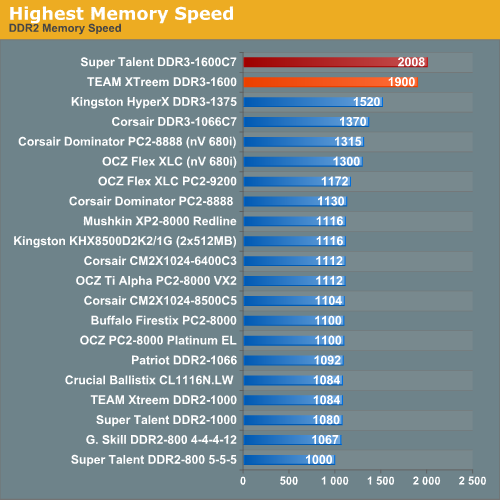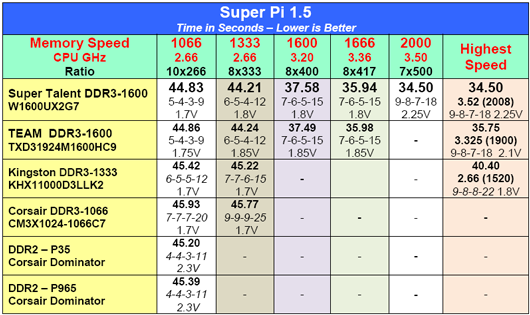Super Talent & TEAM: DDR3-1600 Is Here!
by Wesley Fink on July 20, 2007 11:30 AM EST- Posted in
- Memory
Overclocking
The best way to illustrate the significance of these two new DDR3-1600 memories is to show how fast they can go and the aggressive timings each memory can run at these high speeds. The highest overclock that could be reached with stability with any tested DDR3 previously was with Kingston DDR3-1375 which reached DDR3-1520 at 9-8-8-22 timings at 1.8V. Perhaps more significant the Kingston ran DDR3-1500 at 7-7-7 timings with complete stability.

The TEAM DDRIII 1600 may be rated at 9-9-9-timings, but it reached DDR3-1600 at 7-6-5-15 timings and then went on to stable performance on our test bed at DDR3-1900. Even more impressive is the Super Talent DDR3-1600, which did the same 7-6-5-15 timings at DDR3-1600, but went even further at the top to a stable DDR3-2000 at 9-8-7 timings at 2.25V. The Super Talent topped out at DDR3-2008, but test results were all but identical to the DDR3-2000 results and are not reported.
Advances in memory technology are rarely as dramatic as the speed and timing improvements we are seeing here with Micron Z9 memory chips. For reference we included our ongoing overclocking chart results for DDR2 just so you can see how significant the new Micron Z9 memory really is. The highest DDR2 we have ever tested is an OCZ memory at 1315 in an EVGA 680i motherboard. Early DDR3-1066 reached a bit higher as in the typical 1370 achieved with the launch Corsair DDR3-1066. Timings, however, were somewhat slow. Then the Kingston HyperX pushed 7-7-7 timings all the way to DDR3-1500. Now, less than 2 months later state-of-the-art DDR3 is reaching DDR3-2000+ at aggressive timings. This kind of progress in memory technology makes the original JEDEC target of 800 to 1600 for DDR3 speeds now appear far too limited.
Super Pi
In Kingston Launches Low-Latency DDR3 memory performance was compared at 800, 1066, 1333, and highest memory speed we could reach. With the introduction of higher speed DDR3 the 800 MHz memory speed will be dropped from comparisons. If you are interested in DDR2-800 or DDR3-800 performance for comparison please refer to the Kingston review. In all cases, P965 and P35-DDR2, the performance of the DDR2 Corsair Dominator was highest at DDR2-1066
For this and subsequent DDR3 reviews performance will be compared at 1066, 1333, 1600, 1666 (the next 1333 memory speed), 2000, and the highest memory speed for the tested memory. 1000 is the logical base for the 333 strap but 1066 is the more familiar reference speed. We will use 1066 as the base comparison with a possible change to 1000 base speed in the future.
To look at pure number crunching, Super Pi 1.5 was run in all memory test configurations. Super Pi is a very simple program as it merely calculates the value of Pi to a designated number of decimal positions. In this case we chose 2 million places.
The lower latency of the new DDR3-1600 kits make it the clear performance leader in Super Pi results - from 1066 all the way to the fastest DDR3-2000. This is certainly a change from earlier DDR3 numberr crunching tests where Super Pi was fastest at 1066 on the P35 DDR2 platforms, with the P965 running the same memory close behind, and DDR3 further back in the performance pack. Lower Latency DDR3 now has DDR3 at the top in number crunching at all speeds. We speculated in our Kingston review that lower latency DDR3 would likely overtake DDR2 performance in the future - even at overlap speeds. It appears that DDR3-1066 at 5-4-3 timings is low enough to move DDR3 to the top in Super Pi.
It is interesting that the Kingston DDR3-1375 nearly closed the gap with the fastest 3-3-3 DDR2 memory available, and the DDR3-1600 kits finally pass the fastest DDR2. This clearly demonstrates you will not have to give up a thing with DDR3 in the overlap speeds and you will gain 1333 and higher speeds as well. The only current roadblock to DDR3 is the high price of admission. .
The best way to illustrate the significance of these two new DDR3-1600 memories is to show how fast they can go and the aggressive timings each memory can run at these high speeds. The highest overclock that could be reached with stability with any tested DDR3 previously was with Kingston DDR3-1375 which reached DDR3-1520 at 9-8-8-22 timings at 1.8V. Perhaps more significant the Kingston ran DDR3-1500 at 7-7-7 timings with complete stability.

The TEAM DDRIII 1600 may be rated at 9-9-9-timings, but it reached DDR3-1600 at 7-6-5-15 timings and then went on to stable performance on our test bed at DDR3-1900. Even more impressive is the Super Talent DDR3-1600, which did the same 7-6-5-15 timings at DDR3-1600, but went even further at the top to a stable DDR3-2000 at 9-8-7 timings at 2.25V. The Super Talent topped out at DDR3-2008, but test results were all but identical to the DDR3-2000 results and are not reported.
Advances in memory technology are rarely as dramatic as the speed and timing improvements we are seeing here with Micron Z9 memory chips. For reference we included our ongoing overclocking chart results for DDR2 just so you can see how significant the new Micron Z9 memory really is. The highest DDR2 we have ever tested is an OCZ memory at 1315 in an EVGA 680i motherboard. Early DDR3-1066 reached a bit higher as in the typical 1370 achieved with the launch Corsair DDR3-1066. Timings, however, were somewhat slow. Then the Kingston HyperX pushed 7-7-7 timings all the way to DDR3-1500. Now, less than 2 months later state-of-the-art DDR3 is reaching DDR3-2000+ at aggressive timings. This kind of progress in memory technology makes the original JEDEC target of 800 to 1600 for DDR3 speeds now appear far too limited.
Super Pi
In Kingston Launches Low-Latency DDR3 memory performance was compared at 800, 1066, 1333, and highest memory speed we could reach. With the introduction of higher speed DDR3 the 800 MHz memory speed will be dropped from comparisons. If you are interested in DDR2-800 or DDR3-800 performance for comparison please refer to the Kingston review. In all cases, P965 and P35-DDR2, the performance of the DDR2 Corsair Dominator was highest at DDR2-1066
For this and subsequent DDR3 reviews performance will be compared at 1066, 1333, 1600, 1666 (the next 1333 memory speed), 2000, and the highest memory speed for the tested memory. 1000 is the logical base for the 333 strap but 1066 is the more familiar reference speed. We will use 1066 as the base comparison with a possible change to 1000 base speed in the future.
To look at pure number crunching, Super Pi 1.5 was run in all memory test configurations. Super Pi is a very simple program as it merely calculates the value of Pi to a designated number of decimal positions. In this case we chose 2 million places.
 |
| Click to enlarge |
The lower latency of the new DDR3-1600 kits make it the clear performance leader in Super Pi results - from 1066 all the way to the fastest DDR3-2000. This is certainly a change from earlier DDR3 numberr crunching tests where Super Pi was fastest at 1066 on the P35 DDR2 platforms, with the P965 running the same memory close behind, and DDR3 further back in the performance pack. Lower Latency DDR3 now has DDR3 at the top in number crunching at all speeds. We speculated in our Kingston review that lower latency DDR3 would likely overtake DDR2 performance in the future - even at overlap speeds. It appears that DDR3-1066 at 5-4-3 timings is low enough to move DDR3 to the top in Super Pi.
It is interesting that the Kingston DDR3-1375 nearly closed the gap with the fastest 3-3-3 DDR2 memory available, and the DDR3-1600 kits finally pass the fastest DDR2. This clearly demonstrates you will not have to give up a thing with DDR3 in the overlap speeds and you will gain 1333 and higher speeds as well. The only current roadblock to DDR3 is the high price of admission. .










31 Comments
View All Comments
metalgrx - Thursday, December 13, 2007 - link
If you check the official site of TEAM ( http://web.teamgroup.com.tw/teamgroup/en/productDe...">http://web.teamgroup.com.tw/teamgroup/e...php?pd_i... you ll see the PC3 12800 DDR3 1600MHz CL7 (2*1GB),7-7-7-21-2T, 1.75V~1.85V which is available in my country and i must say it's quite cheap compared to the other options...what do you think about this? To set it clearly...should i buy it?Bozo Galora - Friday, July 20, 2007 - link
FWIW: I picked this little blurb up from EVA's forum:Quote:
BTW... The Micron Z9's are just Engineering samples (rev B), while the D9's are going to be on the market soon (if not already out there), and those are the non-Engineering samples.
Hopefully the D9's can overclock as well as the Z9's (or even better)
(Unquote)
So it looks like the DDR3 will also have D9's
DigitalFreak - Friday, July 20, 2007 - link
Wait a sec... so all this Z9 memory being reviewed isn't what will actually be available for sale? I thought these were retail DIMMs?Wesley Fink - Saturday, July 21, 2007 - link
We have kits identified as Retail from both Super Talent and OCZ. Both have also announced the availability of these parts and pricing for the retail parts. TEAM has told us the TEAM kit is an Engineering Sample, but that retail kits will be announced soon.EVGA boards use nVidia chipsets and do not support DDR3. I would guess EVGA and its users would not be happy with DDR3-2000 chips being available as it would likely hurt their sales.
Bozo Galora - Friday, July 20, 2007 - link
Another fine memory review - you da man, Wesley.Please ignore all the knuckle draggers - they have nothing better to do in their boring empty lives than to argue just for for the sake of arguing.
Keep up the good work - don't let the losers get to you.
theprodigalrebel - Friday, July 20, 2007 - link
TEAM's timings are listed as 5-4-3-9 2.1V @ 1900MHz in the 'Highest Speed' column.Wesley Fink - Friday, July 20, 2007 - link
The charts have all been corrected and now show the correct DDR3-1900 TEAM settings of 9-8-7-18 at 2.1V. Since our Web Editor is traveling and not available I ended up redoing the charts myself, so I added a few things like larger type to communicate the winner at each memory speed.strikeback03 - Monday, July 23, 2007 - link
while you're at it, last page, 4th paragraph from the end mentions DDR2-2000 DIMMs, assume that should be DDR3.Wesley Fink - Friday, July 20, 2007 - link
Thank you for pointing that out. It will be corrected.MadBoris - Friday, July 20, 2007 - link
At first I was like wow.Then I saw all DDR2 comparisons were at 33% less CPU frequency.
We need to get back to real world thinking here.
As an example if I am buying a MOBO capable of DDR2 or DDR3 with a 2.8 GHZ CPU. I would like to know what the actual performance difference would be on that platform for extra cost of DDR3. As it is, by guessing, a faster CPU would probably be a better value and keeping DDR2.
Anyway, unique charts and data this time guys. I know it shows the scaling of memory speed and I am sure this some amazing electronic achievement in some laboratory, but it doesn't communicate much value to me until I see some apple to apple comparisons.
I'm sure that will come around next time, looking forward to it.